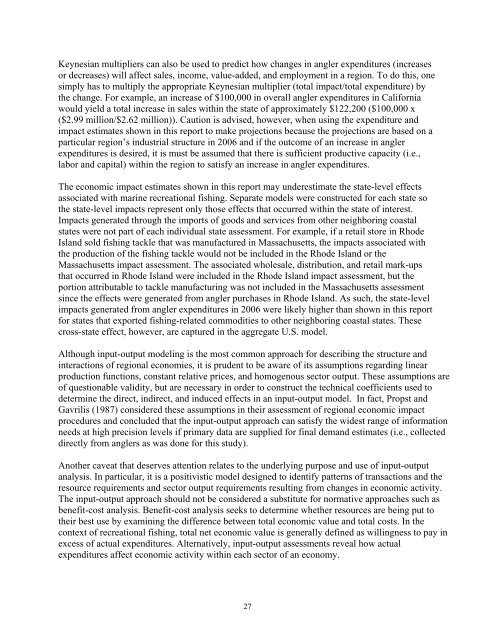The Economic Contribution of Marine Angler Expenditures in the ...
The Economic Contribution of Marine Angler Expenditures in the ...
The Economic Contribution of Marine Angler Expenditures in the ...
Create successful ePaper yourself
Turn your PDF publications into a flip-book with our unique Google optimized e-Paper software.
Keynesian multipliers can also be used to predict how changes <strong>in</strong> angler expenditures (<strong>in</strong>creases<br />
or decreases) will affect sales, <strong>in</strong>come, value-added, and employment <strong>in</strong> a region. To do this, one<br />
simply has to multiply <strong>the</strong> appropriate Keynesian multiplier (total impact/total expenditure) by<br />
<strong>the</strong> change. For example, an <strong>in</strong>crease <strong>of</strong> $100,000 <strong>in</strong> overall angler expenditures <strong>in</strong> California<br />
would yield a total <strong>in</strong>crease <strong>in</strong> sales with<strong>in</strong> <strong>the</strong> state <strong>of</strong> approximately $122,200 ($100,000 x<br />
($2.99 million/$2.62 million)). Caution is advised, however, when us<strong>in</strong>g <strong>the</strong> expenditure and<br />
impact estimates shown <strong>in</strong> this report to make projections because <strong>the</strong> projections are based on a<br />
particular region’s <strong>in</strong>dustrial structure <strong>in</strong> 2006 and if <strong>the</strong> outcome <strong>of</strong> an <strong>in</strong>crease <strong>in</strong> angler<br />
expenditures is desired, it is must be assumed that <strong>the</strong>re is sufficient productive capacity (i.e.,<br />
labor and capital) with<strong>in</strong> <strong>the</strong> region to satisfy an <strong>in</strong>crease <strong>in</strong> angler expenditures.<br />
<strong>The</strong> economic impact estimates shown <strong>in</strong> this report may underestimate <strong>the</strong> state-level effects<br />
associated with mar<strong>in</strong>e recreational fish<strong>in</strong>g. Separate models were constructed for each state so<br />
<strong>the</strong> state-level impacts represent only those effects that occurred with<strong>in</strong> <strong>the</strong> state <strong>of</strong> <strong>in</strong>terest.<br />
Impacts generated through <strong>the</strong> imports <strong>of</strong> goods and services from o<strong>the</strong>r neighbor<strong>in</strong>g coastal<br />
states were not part <strong>of</strong> each <strong>in</strong>dividual state assessment. For example, if a retail store <strong>in</strong> Rhode<br />
Island sold fish<strong>in</strong>g tackle that was manufactured <strong>in</strong> Massachusetts, <strong>the</strong> impacts associated with<br />
<strong>the</strong> production <strong>of</strong> <strong>the</strong> fish<strong>in</strong>g tackle would not be <strong>in</strong>cluded <strong>in</strong> <strong>the</strong> Rhode Island or <strong>the</strong><br />
Massachusetts impact assessment. <strong>The</strong> associated wholesale, distribution, and retail mark-ups<br />
that occurred <strong>in</strong> Rhode Island were <strong>in</strong>cluded <strong>in</strong> <strong>the</strong> Rhode Island impact assessment, but <strong>the</strong><br />
portion attributable to tackle manufactur<strong>in</strong>g was not <strong>in</strong>cluded <strong>in</strong> <strong>the</strong> Massachusetts assessment<br />
s<strong>in</strong>ce <strong>the</strong> effects were generated from angler purchases <strong>in</strong> Rhode Island. As such, <strong>the</strong> state-level<br />
impacts generated from angler expenditures <strong>in</strong> 2006 were likely higher than shown <strong>in</strong> this report<br />
for states that exported fish<strong>in</strong>g-related commodities to o<strong>the</strong>r neighbor<strong>in</strong>g coastal states. <strong>The</strong>se<br />
cross-state effect, however, are captured <strong>in</strong> <strong>the</strong> aggregate U.S. model.<br />
Although <strong>in</strong>put-output model<strong>in</strong>g is <strong>the</strong> most common approach for describ<strong>in</strong>g <strong>the</strong> structure and<br />
<strong>in</strong>teractions <strong>of</strong> regional economies, it is prudent to be aware <strong>of</strong> its assumptions regard<strong>in</strong>g l<strong>in</strong>ear<br />
production functions, constant relative prices, and homogenous sector output. <strong>The</strong>se assumptions are<br />
<strong>of</strong> questionable validity, but are necessary <strong>in</strong> order to construct <strong>the</strong> technical coefficients used to<br />
determ<strong>in</strong>e <strong>the</strong> direct, <strong>in</strong>direct, and <strong>in</strong>duced effects <strong>in</strong> an <strong>in</strong>put-output model. In fact, Propst and<br />
Gavrilis (1987) considered <strong>the</strong>se assumptions <strong>in</strong> <strong>the</strong>ir assessment <strong>of</strong> regional economic impact<br />
procedures and concluded that <strong>the</strong> <strong>in</strong>put-output approach can satisfy <strong>the</strong> widest range <strong>of</strong> <strong>in</strong>formation<br />
needs at high precision levels if primary data are supplied for f<strong>in</strong>al demand estimates (i.e., collected<br />
directly from anglers as was done for this study).<br />
Ano<strong>the</strong>r caveat that deserves attention relates to <strong>the</strong> underly<strong>in</strong>g purpose and use <strong>of</strong> <strong>in</strong>put-output<br />
analysis. In particular, it is a positivistic model designed to identify patterns <strong>of</strong> transactions and <strong>the</strong><br />
resource requirements and sector output requirements result<strong>in</strong>g from changes <strong>in</strong> economic activity.<br />
<strong>The</strong> <strong>in</strong>put-output approach should not be considered a substitute for normative approaches such as<br />
benefit-cost analysis. Benefit-cost analysis seeks to determ<strong>in</strong>e whe<strong>the</strong>r resources are be<strong>in</strong>g put to<br />
<strong>the</strong>ir best use by exam<strong>in</strong><strong>in</strong>g <strong>the</strong> difference between total economic value and total costs. In <strong>the</strong><br />
context <strong>of</strong> recreational fish<strong>in</strong>g, total net economic value is generally def<strong>in</strong>ed as will<strong>in</strong>gness to pay <strong>in</strong><br />
excess <strong>of</strong> actual expenditures. Alternatively, <strong>in</strong>put-output assessments reveal how actual<br />
expenditures affect economic activity with<strong>in</strong> each sector <strong>of</strong> an economy.<br />
27
















